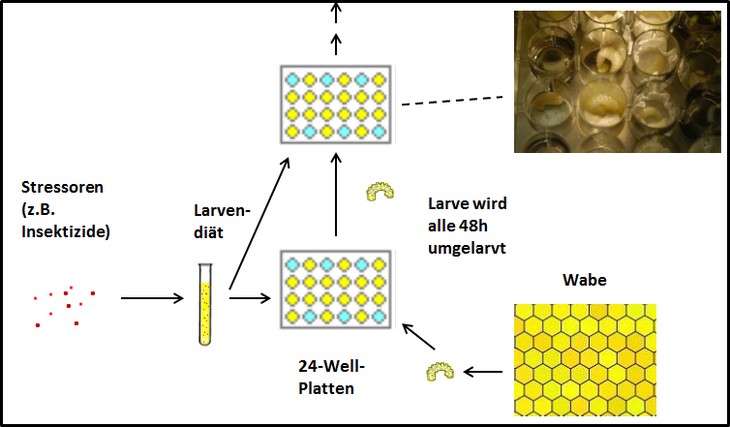Aktuelle Infos
Modul 2 - Diagnose von Schädigungen durch Pflanzenschutzmittel
Verantwortung
Prof. Dr. B. Grünewald, Oberursel
b.gruenewald@bio.uni-frankfurt.de
April 2017
Abschlussbericht des Moduls 2
Mai 2014
Thiacloprid - Langzeitwirkungen des Insektizids auf Bienenvölker – Ergebnisse eines dreijährigen Feldversuches
Hierzu erschien kürzlich ein Beitrag im Deutschen Bienenjournal. Der Bericht „Insektizide im Raps“ (Deutsches Bienenjournal, 5/2014, 22. Jahrgang, S. 6 und 7) ist das Ergebnis der Kooperation aus Modul 1 (Bieneninstitut Kirchhain) und Modul 2 (Institut für Bienenkunde Oberursel).
November 2012
Die Texte und Bilder gibt es auch als Download (PDF-Format).
Effects of thiacloprid on brood activity and the vitality of bee colonies
Honey bees may be exposed to pesticides while collecting nectar and pollen. One of the insecticide compounds frequently detected at low residue levels in hives in Germany is thiacloprid that is applied e. g. in oilseed rape. Concerns have been brought forward that the continuous exposition to low dose levels of pesticides may make bee colonies more susceptible to diseases. We want to analyse whether and how individual bees are influenced by insecticides and how this may have an impact on the vitality of the whole bee colony. For this, we started a field experiment scheduled for three years to simulate chronic uptake of thiacloprid via nectar into the colony. In July 2011 thirty colonies were created from artificial swarms and placed on a location close to the Institute in Kirchhain. They formed three experimental groups with ten colonies per group. Group T1 was fed with sugar syrup containing approximately 200 ppb thiacloprid, group T2 received approximately 2000 ppb thiacloprid and the control group was fed with sugar syrup alone (group K). In intervals of three weeks, we estimated the number of adult bees and the number of brood cells for each colony. Our data indicate differences in the number of brood cells; average value over the period from July to October 2011 amounts to 9976 cells for group K, but only to 8582 cells for group T2. No differences in the number of adult bees were observed. In addition, we took bee samples to perform pathological examinations. We tested the bees for infestation with Varroa destructor and Nosema spp., chronic bee paralysis virus, acute bee paralysis virus and deformed wing virus. While we did not observe differences in Varroa numbers between the groups, the Nosema spore counts and the virus diagnoses are still in progress. The findings of the first year of our study yielded hints that feeding whole bee colonies with sugar syrup containing 2000 ppb thiacloprid may affect brood activity, but it does not seem to have an effect on the vitality of whole bee colonies.
Verhaltensdiagnostik insektizidbehandelter Bienen
Es wurden Elektromyogramme des Proboscismuskels M17 aufgenommen und die Reaktionen auf Zuckerwasserreize beobachtet. Die Neonikotinoide Thiacloprid, Imidacloprid und Clothianidin wurden in die geöffnete Kopfkapsel appliziert und die Muskelspikerate beobachtet.
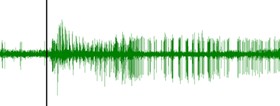
Kontrolle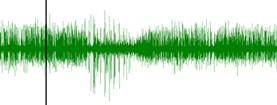
Clothianidin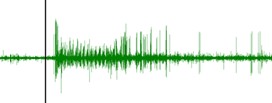
Thiacloprid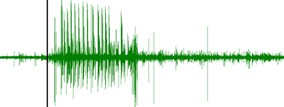
Imidacloprid
Zu beobachten ist eine Verringerung der Muskelaktivität nach der Applikation von Imidacloprid und Thiacloprid, dagegen eine Erhöhung der Muskelaktivität nach der Applikation von Clothianidin.
In vitro Larvenaufzucht
Diese Methode ermöglicht es, die Auswirkungen immunsuprimierender Faktoren oder Stressoren, wie z.B. Insektiziden, Bakterien usw. auf die Entwicklung der Bienenlarven unter kontrollierten Laborbedingungen zu testen.
Dabei werden Larven direkt nach dem Schlupf aus dem Ei (L1-Stadium) einer Brutwabe entnommen und in 24-Wellplatten auf künstlicher Larvendiät mit 48stündigen Umlarvintervallen aufgezogen.
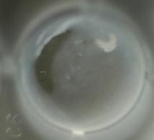
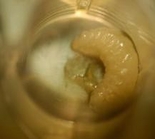
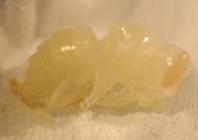
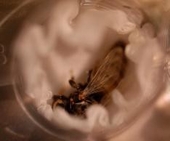
Kontrollierte Laborbedingungen, wie Versuchszeitraum, Temperatur, Luftfeuchtigkeit und Larvendiätzusammensetzung sind maßgeblich für eine Vergleichbarkeit mit einer stets parallel laufenden Kotrollgruppe, die den zu testenden Stressoren nicht ausgesetzt ist.
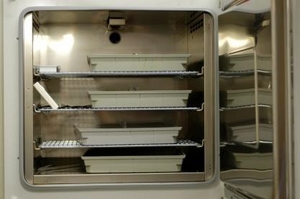
Es können dabei Parameter, wie Überlebensdauer, Entwicklungsverzögerungen z.B. anhand des Verpuppungszeitpunktes, Beweglichkeit und Größe, sowie evtl. Darmvolumina ausgewertet werden.
Versuchsschema
